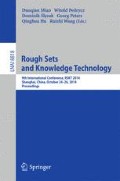Abstract
Sparse representation based classifier (SRC) has been successfully applied in different pattern recognition tasks. Based on the analyses on SRC, we find that SRC is a kind of nearest subspace classifier. In this paper, a new feature extraction algorithm called discriminative principal subspaces alignment (DPSA) is developed according to the geometrical interpretations of SRC. Namely, DPSA aims to find a subspace wherein samples lie close to the hyperplanes spanned by the their homogenous samples and appear far away to the hyperplanes spanned by the their heterogenous samples. Different from the existing SRC-based feature algorithms, DPSA does not need the reconstruction coefficient vectors computed by SRC. Hence, DPSA is much more efficient than the SRC-based feature extraction algorithms. The face recognition experiments conducted on three benchmark face images databases (AR database, the extended Yale B database and CMU PIE) demonstrate the superiority of our DPSA algorithm.
Access this chapter
Tax calculation will be finalised at checkout
Purchases are for personal use only
Preview
Unable to display preview. Download preview PDF.
References
Fukunaga, K.: Introduction to Statistical Pattern Recognition, 2nd ed., Academic Press (1990)
Cheng, H., Vu, K., Hua, K.A.: SubSpace projection: a unified framework for a class of partition-based dimension reduction techniques. Information Sciences 179, 1234–1248 (2009)
Li, X., Tao, D.: Subspace learning. Neurocomputing 73, 10539–10540 (2010)
Turk, M.A., Pentland, A.P.: Face recognition using eigenfaces. In: IEEE Computer Society Conference on Computer Vision and, Pattern Recognition, pp. 586–591 (1991)
Belhumeur, P.N., Hespanha, J.P., Kriegman, D.J.: Eigenfaces vs. fisherfaces: recognition using class specific linear projection. IEEE Transactions on Pattern Analysis and Machine Intelligence 19, 711–720 (1997)
He, X., Yan, S., Hu, Y., Niyogi, P., Zhang, H.J.: Face recognition using laplacianfaces. IEEE Transaction on Pattern Analysis and Machine Intelligence 27(3), 328–340 (2005)
He, X., Cai, D., Yan, S., Zhang, H.: Neighborhood Preserving Embedding. In: ICCV 2005, pp. 1208–1213 (2005)
Yan, S., Xu, D., Zhang, B., Zhang, H., Yang, Q., Lin, S.: Graph embedding and extension: A general framework for dimensionality reduction. IEEE Trans. Pattern Anal. Mach. Intell. 29(1), 40–51 (2007)
Yang, J., Zhang, L., Yang, J.Y., Zhang, D.: From classifiers to discriminators: A nearest neighbor rule induced discriminant analysis. Pattern Recognition 44(7), 1387–1402 (2011)
Mitani, Y., Hamamoto, Y.: A local mean-based nonparametric classifier. Pattern Recognition Letters 27(10), 1151–1159 (2006)
Naseem, I., Togneri, R., Bennamoun, M.: Linear Regression for Face Recognition. IEEE Transaction on Pattern Analysis and Machine Intelligence 32(11), 2106–2112 (2010)
Chen, Y., Jin, Z.: Reconstructive discriminant analysis: A feature extraction method induced from linear regression classification. Neurocomputing 87, 41–50 (2012)
Wright, J., Yang, A., Ganesh, A., Sastry, S., Ma, Y.: Robust face recognition via sparse representation. IEEE Transaction on Pattern Analysis and Machine Intelligence 31(2), 210–227 (2009)
Zhang, L., Yang, M., Feng, X.: Sparse Representation or Collaborative Representation Which Helps Face Recognition. In: ICCV 2011 (2011)
Qiao, L.S., Chen, S.C., Tan, X.Y.: Sparsity preserving projections with applications to face recognition. Pattern Recognition 43(1), 331–341 (2010)
Lu, G.F., Jin, Z., Zou, J.: Face recognition using discriminant sparsity neighborhood preserving embedding. Knowledge-Based Systems 31, 119–127 (2012)
Cui, Y., Zheng, C.H., Yang, J., Sha, W.: Sparse maximum margin discriminant analysis for feature extraction and gene selection on gene expression data. Comput. Biol. Med. 43(7), 933–941 (2013)
Donoho, D.: For most large underdetermined systems of linear equations the minimal l 1-norm solution is also the sparsest solution, Commun. Pure Appl. Math. 59(6), 797–829 (2006)
Tibshirani, R.: Regression shrinkage and selection via the lasso, Journal of the Royal Statistical Society. Series B (Methodological) 58(1), 267–288 (1996)
Martinez, A.M., Benavente, R.: The AR face database, CVC, Univ. Autonoma Barcelona, Barcelona, Spain, Technical Report (June 24, 1998)
Lee, K.C., Ho, J., Driegman, D.: Acquiring linear subspaces for face recognition under variable lighting, IEEE Trans. Pattern Anal. Mach. Intell. 27(5), 684–698 (2005)
Sim, T., Baker, S., Bsat, M.: The CMU pose, illumination, and expression database, IEEE Trans. Pattern Anal. Mach. Intell. 25(12), 1615–1618 (2003)
Liu, J., Ji, S., Ye, J.: SLEP: A Sparse Learning Package. Available (2008), http://www.public.asu.edu/jye02/Software/SLEP/
Author information
Authors and Affiliations
Corresponding author
Editor information
Editors and Affiliations
Rights and permissions
Copyright information
© 2014 Springer International Publishing Switzerland
About this paper
Cite this paper
Wei, L. (2014). Optimal Subspace Learning for Sparse Representation Based Classifier via Discriminative Principal Subspaces Alignment. In: Miao, D., Pedrycz, W., Ślȩzak, D., Peters, G., Hu, Q., Wang, R. (eds) Rough Sets and Knowledge Technology. RSKT 2014. Lecture Notes in Computer Science(), vol 8818. Springer, Cham. https://doi.org/10.1007/978-3-319-11740-9_30
Download citation
DOI: https://doi.org/10.1007/978-3-319-11740-9_30
Publisher Name: Springer, Cham
Print ISBN: 978-3-319-11739-3
Online ISBN: 978-3-319-11740-9
eBook Packages: Computer ScienceComputer Science (R0)

